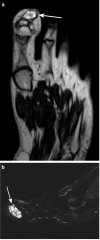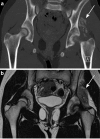Non Lipomatous Benign Lesions Mimicking Soft-tissue Sarcomas: A Pictorial Essay
- PMID: 29475903
- PMCID: PMC5905188
- DOI: 10.21873/invivo.11228
Non Lipomatous Benign Lesions Mimicking Soft-tissue Sarcomas: A Pictorial Essay
Abstract
The incidental finding of soft tissue masses is a challenge for the radiologist. Benign and malignant lesions can be differentiated relying on patient history, symptoms and mostly with the help of imaging. Ultrasound (US), computed tomography (CT) and magnetic resonance imaging (MRI) become fundamental in order to distinguish these lesions but the radiologist needs to know the main characteristics of benign soft tissue masses and sarcomas. Herein, we present a pictorial review of lesions mimicking soft tissue sarcomas features.
Keywords: MRI; Sarcoma; mimics; review.
Copyright© 2018, International Institute of Anticancer Research (Dr. George J. Delinasios), All rights reserved.
Figures












References
-
- Bridge JA, Hogendoorn P, Bridge JA, Fletcher CD. WHO classification of tumours of soft tissue and bone. International Agency for Research on Cancer. 2013
-
- McKenzie G, Raby N, Ritchie D. Non-neoplastic soft-tissue masses. Br J Radiol. 2009;82(981):775–785. - PubMed
-
- Murphey MD, Vidal JA, Fanburg-Smith JC, Gajewski DA. Imaging of synovial chondromatosis with radiologic-pathologic correlation. Radiographics. 2007;27(5):1465–1488. - PubMed
-
- Flors L, Leiva-Salinas C, Maged IM, Norton PT, Matsumoto AH, Angle JF, Hugo Bonatti M, Park AW, Ahmad EA, Bozlar U, Housseini AM, Huerta TE, Hagspiel KD. MR imaging of soft-tissue vascular malformations: diagnosis, classification, and therapy follow-up. Radiographics. 2011;31(5):1321–1340. - PubMed
Publication types
MeSH terms
LinkOut - more resources
Full Text Sources
Other Literature Sources
Medical
